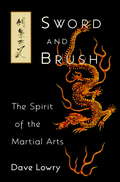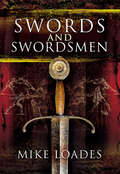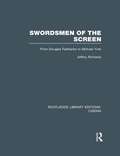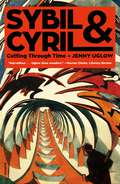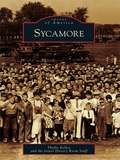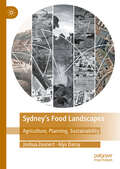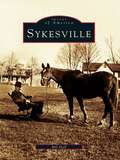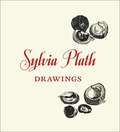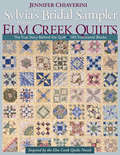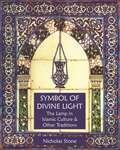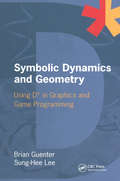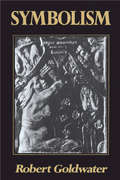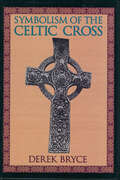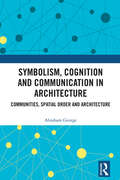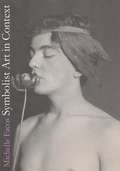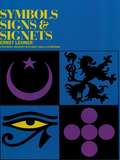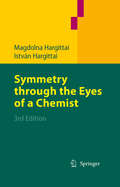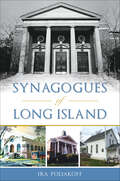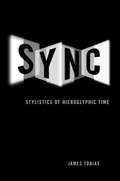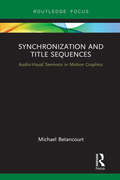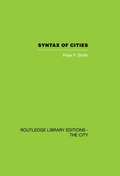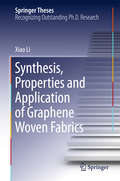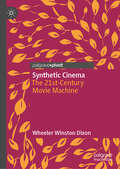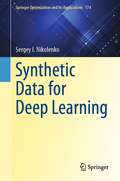- Table View
- List View
Sword and Brush: The Spirit of the Martial Arts
by Dave LowryThis moment of perfect clarity that is the force behind all the traditional Japanese arts--from archery to flower arranging--is celebrated here in Dave Lowry's exploration of the common principles shared by calligraphy and the martial arts. Forty-two examples of Lowry's calligraphy, accompanied by his essays, show how the way of the brush reflects the strategic principles of the way of the sword. Each calligraphy represents a term from the martial arts--such as do, the way, or wa, harmony. The accompanying text amplifies our understanding of the term, what it meant to Japanese warriors, and what it means to practitioners of calligraphy and the martial arts today. What becomes clear is that these two seemingly unrelated disciplines actually partake of the same profound elemental spirit.
Swords and Swordsmen
by Mike Loades&“A &‘must have&’ book for anyone who has an interest in edged weapons . . . Loades holds the reader&’s full attention with each sword&’s story that he tells.&” —The Lone Star Book Review This magnificent book tells the story of the evolution of swords, how they were made, how they were used, and the people that used them. It doesn&’t claim to give comprehensive coverage but instead takes certain surviving examples as landmarks on a fascinating journey through the history of swords. Each is selected because it can be linked to a specific individual, thus telling their story too and giving a human interest. So the journey starts with the sword of Tutankhamun and ends with the swords of J. E. B. Stuart and George Custer. Along the way we take in Henry V, Cromwell and Uesugi Kenshin, and there is the most detailed discussion you&’ll find anywhere of all of George Washington&’s swords. The chapters on these specific swords and swordsmen are alternated with more general chapters on the changing technical developments and fashions in swords and their use. The reader&’s guide on this historical tour is Mike Loades. Mike has been handling swords most of his life, as a fight arranger, stuntman and historical weapons expert for TV and stage. As much as his profound knowledge of the subject, it is his lifelong passion for swords that comes through on every page. His fascinating text is supported by a lavish wealth of images, many previously unpublished and taken specifically for this book.&“Superb . . . the most breathtaking coverage from the earliest days to modern times. Brilliant.&” —Books Monthly
Swordsmen of the Screen: From Douglas Fairbanks to Michael York (Routledge Library Editions: Cinema)
by Jeffrey RichardsThis fascinating study of the genre of swashbuckling films received wide critical acclaim when it was first published in 1977. Jeffrey Richards assesses the contributions to the genre of directors, designers and fencing masters, as well as of the stars themselves, and devotes several chapters to the principal subjects if the swashbucklers – pirates, highwaymen, cavaliers and knights. The result is to recall, however fleetingly, the golden days of the silver screen. Reviews of the original edition: ‘An intelligent, scholarly, well-written account of adventure films, this work is sensitive both to cinema history and to the literary origins of the "swashbuckler"….Essential for any library with books on film, it may very well be the definitive book on its subject.’ – Library Journal
Sybil & Cyril: Cutting Through Time
by Jenny UglowFrom Jenny Uglow, one of our most admired writers, a beautifully illustrated story of a love affair and a dynamic artistic partnership between the wars. In 1922, Cyril Power, a fifty-year-old architect, left his family to work with the twenty-four-year-old Sybil Andrews. They would be together for twenty years. Both became famous for their dynamic, modernist linocuts—streamlined, full of movement and brilliant color, summing up the hectic interwar years. Yet at the same time, they looked back to medieval myths and early music, to country ways that were disappearing from sight. Jenny Uglow’s Sybil & Cyril: Cutting Through Time traces their struggles and triumphs, conflicts and dreams, following them from Suffolk to London, from the New Forest to Vancouver Island. This is a world of futurists, surrealists, and pioneering abstraction, but also of the buzz of the new, of machines and speed, of shops and sport and dance, shining against the threat of depression and looming shadows of war.
Sycamore
by Phyllis Kelley Joiner History Room StaffThe attractions of Sycamore include its majestic 1904 county courthouse, domed Carnegie library, well-appointed Victorian homes and tree-lined streets, and flourishing central business district located on a broad main street first laid out in the mid-19th century. The 1¢ parking meters are a nice touch too. This DeKalb County seat retains the charming appearance of a fictional midwestern "small-town USA." Now known far and wide for its annual pumpkinfestival in October, Sycamore has a rich historical past. In Sycamore, readers will discover people, businesses, organizations, and events that contributed to this community becoming a place where the slogan "Life Offers More in Sycamore" was a natural.
Sydney’s Food Landscapes: Agriculture, Planning, Sustainability
by Joshua Zeunert Alys DaroyThe story of Sydney’s metropolitan food landscapes is one of dramatic transformations of First Nations land amidst jostles for power and wealth. This book unearths Sydney's lost commercial agriculture since colonisation in 1788 to assess its fragile food futures. Richly illustrated, 270 images are encapsulated within 110 figures, including an array of original metropolitan-scale mappings. Discussion traverses the city’s diverse cultural influences, from Indigenous land management to British pastoralism, Chinese cultivation of Sydney’s “backyard vegetable garden” and southern European farming spawning billion-dollar empires. The region has further been shaped by a vast array of cultural and ideological factors and material practices, with relevance to planning, policy, ethics, geography, heritage, art, design and technology. This book is the first to bring Sydney’s disparate post-colonial food histories together in one volume to explore the dynamics and tensions between urban growth and food production. The relevance of Sydney’s food landscapes therefore extends far wider than the city itself, with implications for countless regions worldwide in a time of increasing climate and resource precarity.
Sykesville
by Bill HallA picturesque, little town located along the banks of the rolling Patapsco River, Sykesville, Maryland has had a long and distinctive history. Though not officially incorporated until 1904, Sykesville was first put on the map when, in 1831, the mighty Baltimore and Ohio Railroad sent its "Old Main Line" from the thriving metropolis of Baltimore to Point of Rocks in Frederick County, Maryland and traveled through the small town of Sykesville on its route. After that, tourism became an important industry in the town, as well-to-do Baltimoreans searched for a country refuge during the hot summer months. Sykesville, located in Carroll County and just 30 miles from Baltimore city, was the perfect spot to enjoy a relaxed and shady holiday.As Sykesville grew and changed over the years, many individuals, including Suzannah Warfield, Frank Brown, Wade Warfield, J.H. Fowble, E. Francis Baldwin, and Edwin Mellor, played important roles in the town's commercial development. But it is Sykesville's unique heritage, the great value placed on preserving that past by residents, and the resilient character of the community that has made Sykesville what it is today. Following a decline in the 1970s, the town experienced a rebirth fostered by the tenacious spirit of local officials and residents who strongly believed that the town could regain its past glory. Now, as one strolls along Sykesville's downtown streets, the past seems once again alive and the community's singular story is at the heart of it all.
Sylvia Plath: Drawings
by Sylvia PlathIn 1956 Sylvia Plath wrote to her mother, Aurelia, 'I feel I'm developing a kind of primitive style of my own which I am very fond of. Wait 'til you see . . . 'Throughout her life Plath cited art as her deepest source of inspiration; yet while her writing is celebrated around the world, her drawings are little known. This publication brings together drawings from 1955 to 1957, the period she spent on a Fulbright fellowship at Newnham College, Cambridge. During this time she met and married in secret the poet Ted Hughes, travelling with him on honeymoon to Paris and Spain before their return to the US in June 1957. Plath's drawings in pen and ink are exquisitely observed moments from this period in her life, and include among their subjects Parisian rooftops, trees, churches and a portrait of Ted Hughes. The collection sheds light on these key years in Plath's life and includes letters and a diary entry about her art, as well as an illuminating introduction by her daughter, Frieda Hughes.
Sylvia's Bridal Sampler from Elm Creek Quilts: The True Story Behind the Quilt—140 Traditional Blocks
by Jennifer ChiaveriniThe New York Times–bestselling author of the Elm Creek Quilts Novels shares 140 block patterns so you can make your own version of this heirloom quilt! Celebrate the enduring bonds of friendship and create your own authentic version of the &“secret&” bridal sampler from the beloved novel The Master Quilter. Get together with other quilters to mix, match, and share 140 traditional blocks. Enjoy the gallery of sampler quilts made by other Elm Creek readers. This book includes complete instructions and links to full-sized patterns for every block from the sampler.
Symbol of Divine Light: The Lamp in Islamic Culture and Other Traditions
by Nicholas StoneSymbol of Divine Light surveys the history of the mosque lamp, describing the numerous variants made in different historical periods and containing more than 200 stunning color and b/w illustrations. The deep significance of light and the lamp in Islamic culture and other traditions—Jewish, Christian, Zoroastrian, Hindu, and Buddhist—is also explored, with reference made to the writings of authors belonging to the &“Traditionalist school,&” notably Frithjof Schuon, René Guénon, Titus Burckhardt, and Martin Lings. The book presents a detailed exploration of the famous Koranic Verse of Light and the symbolism of its constituent elements: light, the niche, the lamp, glass, oil, and the tree. Parallels are also drawn with other traditions, indicating a universal symbolism.Symbol of Divine Light concludes that the most important function of the mosque lamp was as a symbolic reminder of the Verse of Light, as demonstrated by examples that were virtually non-functional as lighting devices and also the extensive use of the mosque lamp as a decorative motif in Islamic architecture. The book aims to give the reader an opportunity to contemplate the meaning of the mosque lamp as a symbol of Divine Light.
Symbolic Dynamics and Geometry: Using D* in Graphics and Game Programming
by Brian Guenter Sung-Hee LeeThis book explains how to use the symbolic differentiation system D* for applications in computer games and engineering simulation. The authors describe how to create procedural 3D geometric models, link them together to form multibody physical systems, and simulate and display their physical behavior in real time. The symbolic differentiation capabilities of D* can be used in a wide variety of technical applications, including computer graphics, engineering, and mechanical simulation. Two Lagrangian physics simulation and procedural 3D geometric modeling are developed in great detail.
Symbolism
by Robert GoldwaterThis encyclopedic guide explores the rich and varied meanings of more than 2,000 symbols?from amethyst to Zodiac.
Symbolism of the Celtic Cross
by Derek BryceA guide to the basic symbolism of the Celtic Cross, featuring rare illustrations.Did you know that the basic symbolism of the cross is that of the world axis, or the link between Heaven and Earth? Or that the main feature of the ornamented Celtic Cross, the wheel cross, is not derived from the crucifixion, but from a more ancient symbol the Chi-Rho monogram, which is the name of Christ in the Greek alphabet?In Symbolism of the Celtic Cross, Derek Bryce traces the pagan-Christian link of the essential symbolism of the axis mundi from standing stones and market crosses (at crossroads and not always “crosses” in form) to the inscribed slabs and freestanding crosses of the Celtic-Christian era. He includes rare illustrations of ornamental Celtic Crosses from such places as Brittany, Wales, Scotland, the Isle of Man, Cumbria, Ireland, and Cornwall. Bryce explores esoteric aspects of the symbolism, alchemy, and the wisdom of Hermes.
Symbolism, Cognition and Communication in Architecture: Communities, Spatial Order and Architecture
by Abraham GeorgeThis book discusses the role and significance of symbols and symbolism in graphical communication toward the establishment of meaningful architecture. It explores how these are effectively applied in architectural education for the empowerment of learners in various cultures around the world. The volume examines the developments in graphic representations while recognizing the importance of cognition and its perception in spatial terms. In a scenario where architectural education is at crossroads, facing challenges of a global nature, this book highlights the importance of understanding architectural curriculum and design subjects. The author discusses the issues of communicating the knowledge of architecture to heterogeneous groups of students and explains how design fields and learning in architecture can be modified through cognitive instructional methods. The book outlines the methodology to develop symbols and symbolic pedagogical tools for effective communication in architecture. The book will appeal to students, researchers, teachers and scholars of architecture, design, planning and visual communication. It will also be of interest to architects, artists, spatial designers, town planners, urban planners and professionals.
Symbolist Art in Context
by Michelle FacosThis book offers a straightforward definition of Symbolism as the starting point for investigating a complex and imprecisely understood art movement based on two factors: authorial intention and aesthetic qualities.
Symbols, Signs and Signets
by Ernst LehnerReproducing in historical sequence 1355 signs, seals, and symbols from the simplest drawings of heavenly bodies, through the intricate heraldic devices of the Middle Ages, to modern cattle brands and hobo sign language, this book will be of immense value to the commercial artist and designer. The development of man as an artist and designer is here recorded pictorially by one of the world's foremost experts in the field of graphic art, Ernst Lehner.This book is divided into 13 sections, each with a separate brief introduction: Symbolic Gods and Deities (Egyptian, Babylonian, Greek, Germanic, Incan, Aztec, Hindu, Buddhist, Taoist, etc.); Astronomy and Astrology; Alchemy, Magic, and Mystic (Nordic runes, magic circles, etc.); Church and Religion; Heraldry (coats of arms, badges, etc.); Monsters and Imaginary Figures; Japanese Crests; Marks and Signets (engravers, goldsmiths, armorers, stonemasons, etc.); Watermarks (fourteenth-eighteenth centuries); Printer's Marks (fifteenth-seventeenth centuries); Cattle Brands; and Hobo Signs. All the signs, symbols, and signets are pictured in black and white on strikingly laid out pages, with full explanatory notes for both lay readers and specialists.Anyone interested in means of communication other than language will find this book fascinating and authoritative. The student and teacher in the graphic arts will find it a practical visual guide through the transformation of simple marks and signs into the complicated emblems of our time.
Symmetry through the Eyes of a Chemist
by Istvan Hargittai Magdolna HargittaiThis is the first book to comprehensively survey chemistry from the point of view of symmetry. It contains many examples from chemistry as well as from other fields which emphasize the unifying nature of the symmetry concept.
Synagogues of Long Island (Landmarks)
by Ira PoliakoffLong Island has one of the most vibrant and largest Jewish communities in the nation.After World War II, hundreds of thousands of Jewish soldiers returned from war looking for a life in the suburbs and synagogues to join, but the demand exceeded the supply. In 1946, Rabbi Elias Solomon called a meeting of Conservative rabbis from Manhattan to map out a plan to build a synagogue at ever South Shore Long Island Railroad stop, from Valley Stream to Patchogue. Central Synagogue of Nassau County and Beth El in Great Neck both grew to more than 1000 families as Reform Judaism took hold, and the growth of the Chabad movement in recent decades as spurred an increase of Orthodox Judaism. Author Ira Poliakoff catalogues the history of synagogues and congregations that have shaped Long Island's past and present.
Sync: Stylistics of Hieroglyphic Time
by James TobiasIn Sync, James Tobias examines the development of musical sound and image in cinema and media art, indicating how these elements define the nature and experience of reception. Placing musicality at the center of understanding streaming media, Tobias presents six interwoven stories about synchronized audiovisual media—from filmmaker Sergei Eisenstein’s Alexander Nevskyto today’s contemporary digital art and computer games—to show how these effects are never merely "musical" in the literal sense of organized sound.
Synchronization and Title Sequences: Audio-Visual Semiosis in Motion Graphics (Routledge Studies in Media Theory and Practice)
by Michael BetancourtSynchronization and Title Sequences proposes a semiotic analysis of the synchronization of image and sound in motion pictures using title sequences. Through detailed historical close readings of title designs that use either voice-over, an instrumental opening, or title song to organize their visuals—from Vertigo (1958) to The Player (1990) and X-Men: First Class (2011)—author Michael Betancourt develops a foundational framework for the critique and discussion of motion graphics’ use of synchronization and sound, as well as a theoretical description of how sound-image relationships develop on-screen.
SynergiCity: Reinventing the Postindustrial City
by Richard Florida Paul J. Armstrong Paul Hardin KappSynergiCity: Reinventing the Postindustrial City proposes a new and invigorating vision of urbanism, architectural design, and urban revitalization in twenty-first-century America. Culling transformative ideas from the realms of historic preservation, sustainability, ecological urbanism, and the innovation economy, Paul Hardin Kapp and Paul J. Armstrong present a holistic vision for restoring industrial cities suffering from population decline back into stimulating and productive places to live and work. With a particular emphasis on the Rust Belt of the American Midwest, SynergiCity argues that cities such as Detroit, St. Louis, and Peoria must redefine themselves to be globally competitive. This revitalization is possible through environmentally and economically sustainable restoration of industrial areas and warehouse districts for commercial, research, light industrial, and residential uses. The volume's expert researchers, urban planners, and architects draw on the redevelopment successes of other major cities--such as the American Tobacco District in Durham, North Carolina, and the Milwaukee River Greenway--to set guidelines and goals for reinventing and revitalizing the postindustrial landscape. Contributors are Paul J. Armstrong, Donald K. Carter, Lynne M. Dearborn, Norman W. Garrick, Mark L. Gillem, Robert Greenstreet, Craig Harlan Hullinger, Paul Hardin Kapp, Ray Lees, Emil Malizia, John O. Norquist, Christine Scott Thomson, and James H. Wasley.
Synthesis, Properties and Application of Graphene Woven Fabrics
by Xiao LiThis thesis reports on innovations in the design and direct synthesis of graphene-based woven fabric (GWF) and multi-layer graphene/porous carbon woven fabric films (MLG/PC) by means of chemical vapor deposition (CVD), using woven copper mesh and nickel mesh as the template. Further, it presents the successful applications of these materials as a platform for solar cells, super capacitors and sensors, making it especially of interest to researchers and graduate students in the fields of materials sciences, nanotechnology and renewable energy.
Synthetic Cinema: The 21st-Century Movie Machine
by Wheeler Winston DixonIn this book, Wheeler Winston Dixon argues that 21st-century mainstream filmmaking is increasingly and troublingly dominated by "synthetic cinema." He details how movies over the last two decades have fundamentally abandoned traditional filmmaking values through the overwhelming use of computer generated imagery, digital touch ups for the actors, and extensive use of green screen technology that replace sets and location shooting. Combined with the shift to digital cinematography, as well as the rise of comic book and franchise cinema, the temptation to augment movies with lavish, computer generated spectacle has proven irresistible to both directors and audiences, to the point that, Dixon argues, 21st-century commercial cinema is so far removed from the real world that it has created a new era of flawless, fake movies.
Synthetic Data for Deep Learning (Springer Optimization and Its Applications #174)
by Sergey I. NikolenkoThis is the first book on synthetic data for deep learning, and its breadth of coverage may render this book as the default reference on synthetic data for years to come. The book can also serve as an introduction to several other important subfields of machine learning that are seldom touched upon in other books. Machine learning as a discipline would not be possible without the inner workings of optimization at hand. The book includes the necessary sinews of optimization though the crux of the discussion centers on the increasingly popular tool for training deep learning models, namely synthetic data. It is expected that the field of synthetic data will undergo exponential growth in the near future. This book serves as a comprehensive survey of the field. In the simplest case, synthetic data refers to computer-generated graphics used to train computer vision models. There are many more facets of synthetic data to consider. In the section on basic computer vision, the book discusses fundamental computer vision problems, both low-level (e.g., optical flow estimation) and high-level (e.g., object detection and semantic segmentation), synthetic environments and datasets for outdoor and urban scenes (autonomous driving), indoor scenes (indoor navigation), aerial navigation, and simulation environments for robotics. Additionally, it touches upon applications of synthetic data outside computer vision (in neural programming, bioinformatics, NLP, and more). It also surveys the work on improving synthetic data development and alternative ways to produce it such as GANs. The book introduces and reviews several different approaches to synthetic data in various domains of machine learning, most notably the following fields: domain adaptation for making synthetic data more realistic and/or adapting the models to be trained on synthetic data and differential privacy for generating synthetic data with privacy guarantees. This discussion is accompanied by an introduction into generative adversarial networks (GAN) and an introduction to differential privacy.
